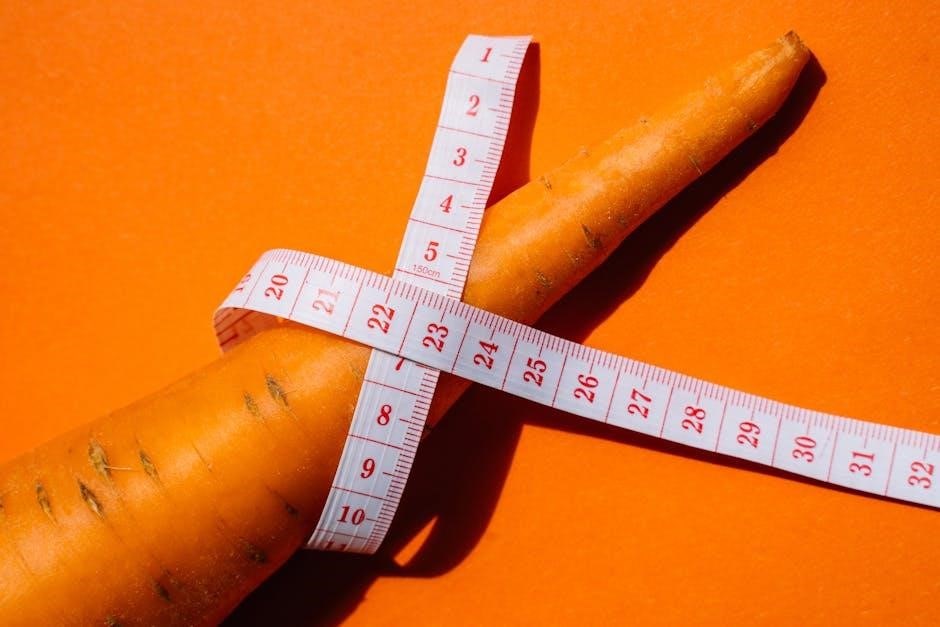The glycemic index (GI) measures how foods affect blood sugar levels. It helps identify carbs that raise glucose slowly, aiding in blood sugar management and weight loss. Low GI diets are particularly beneficial for diabetics and those seeking to reduce chronic disease risks, promoting a healthier lifestyle through informed food choices.
What is the Glycemic Index?
The glycemic index (GI) is a scale measuring how quickly foods raise blood sugar levels. It assigns a numeric value to carbohydrate-containing foods, indicating their impact on blood glucose. Pure glucose is set at 100, and other foods are compared to this reference. Low GI foods (55 or below) release glucose slowly, while high GI foods cause rapid spikes. This index helps individuals, especially diabetics, make informed dietary choices to manage blood sugar effectively and maintain metabolic health. Understanding the GI is key to selecting foods that align with health goals.
How the Glycemic Index Affects Blood Sugar Levels
The glycemic index (GI) determines how quickly carbohydrate-containing foods raise blood sugar levels. Foods with a high GI cause rapid spikes in blood glucose, triggering a sharp insulin response. In contrast, low GI foods release glucose slowly, leading to gradual increases in blood sugar. This makes low GI foods ideal for stabilizing blood sugar levels, particularly for individuals with diabetes. By managing blood sugar fluctuations, the GI helps prevent energy crashes and supports long-term metabolic health, aligning with the principles of a balanced low glycemic diet for better blood sugar control and overall well-being.

Benefits of a Low Glycemic Diet
A low glycemic diet promotes stable blood sugar levels, aids in weight loss, and reduces the risk of chronic diseases like diabetes and heart disease, improving overall health.
Weight Loss and Satiety
Low glycemic foods promote weight loss by releasing glucose slowly, keeping you fuller longer and reducing hunger. This prevents overeating and supports sustained energy levels. Key factors include delayed digestion, which avoids blood sugar spikes and crashes, and increased satiety from fiber-rich foods. A low GI diet helps manage portion control and reduces overall calorie intake, making it easier to maintain a healthy weight. This approach is especially beneficial for those aiming to lose weight while balancing blood sugar levels and improving metabolic health.
Reducing the Risk of Chronic Diseases
A low glycemic diet lowers the risk of chronic diseases like type 2 diabetes and heart disease. By stabilizing blood sugar, it reduces insulin resistance and inflammation. Studies show that consistent consumption of low GI foods can prevent sudden glucose spikes, protecting against complications. This dietary approach also supports heart health by improving cholesterol levels and blood pressure, further reducing cardiovascular risks. Incorporating low GI foods is a proactive step toward long-term health and disease prevention, benefiting overall well-being and longevity.

Low Glycemic Food List
A low glycemic diet includes whole grains, non-starchy vegetables, legumes, and fruits like berries and citrus. Foods like broccoli, spinach, and avocados are also ideal choices for balancing blood sugar levels naturally.
Best Low Glycemic Foods for Diabetics
The best low glycemic foods for diabetics include non-starchy vegetables like broccoli, spinach, and leafy greens, which are low in carbs and rich in fiber. Lean proteins such as chicken, turkey, and fish are also ideal, as they do not raise blood sugar levels. Avocados, nuts, and seeds provide healthy fats and fiber, while legumes like lentils and chickpeas offer slow-digesting carbs. Whole grains like quinoa and barley, and fruits like berries, citrus, and apples, are excellent choices due to their low GI and high fiber content, helping manage blood sugar and promote satiety.
Low Glycemic Drinks and Their Benefits
Low glycemic drinks are essential for maintaining stable blood sugar levels and hydration. Water is the best choice, as it has no calories or carbs. Herbal teas, such as peppermint or chamomile, are also ideal due to their zero glycemic impact. Low-fat milk and unsweetened almond milk are excellent options, providing nutrients without spiking blood sugar. Moderate consumption of fruit juices, like apple or orange, is acceptable, but portion control is key. These drinks support blood sugar balance, hydration, and overall health, making them a great addition to a low glycemic diet.
Glycemic Load and Its Importance
Glycemic load (GL) combines glycemic index and carbohydrate content, providing a practical measure of a food’s blood sugar impact. It helps avoid spikes, aids weight management, and supports long-term health.
Understanding Glycemic Load
Glycemic load (GL) is a measure that combines the glycemic index (GI) of a food with its carbohydrate content; It provides a more accurate assessment of how a food affects blood sugar levels compared to GI alone. GL is calculated as the product of the food’s GI and the amount of available carbohydrates in a serving, divided by 100. A GL of 10 or less is considered low, between 11 and 19 is medium, and 20 or higher is high. This metric helps individuals, especially those managing diabetes, make informed dietary choices to maintain stable blood glucose levels.

Calculating Glycemic Load
Glycemic load (GL) is calculated by multiplying the glycemic index (GI) of a food by the grams of available carbohydrates in a serving and then dividing by 100. This formula provides a clearer picture of how a specific portion of food impacts blood sugar levels. For example, a food with a GI of 71 and 8 grams of carbs has a GL of 5.7. Understanding GL helps individuals make better dietary choices, especially for managing conditions like diabetes, by considering both the quality and quantity of carbohydrates consumed.

Managing Blood Sugar with Low GI Foods
Low GI foods help manage blood sugar by releasing glucose slowly, preventing spikes. They promote satiety, aid weight loss, and improve insulin sensitivity, essential for diabetes control. Incorporating whole grains, legumes, and non-starchy vegetables supports stable blood sugar levels and overall health.

Importance of Glycemic Index for People with Diabetes
Importance of Glycemic Index for People with Diabetes
The glycemic index (GI) is crucial for managing blood sugar levels in diabetes. It helps identify foods that cause gradual glucose increases, preventing sharp spikes. By choosing low GI foods, individuals with diabetes can better control their blood sugar, reduce insulin demands, and minimize complications like heart disease. This approach supports long-term health and stability, enabling diabetics to maintain balanced glucose levels without extreme fluctuations. The GI is a vital tool for creating personalized meal plans tailored to diabetic needs, ensuring safer and more effective blood sugar management.
Indications for Consuming Foods with Different Glycemic Indexes
People with diabetes should tailor their food choices based on glycemic index (GI) levels to maintain stable blood sugar. Low GI foods are ideal for daily meals, as they prevent sharp glucose spikes. Medium GI foods can be included in balanced diets but require portion control. High GI foods are best reserved for specific situations, like rapid glucose recovery after exercise or treating hypoglycemia. This personalized approach ensures better blood sugar management and reduces the risk of complications. Understanding GI helps create a diet plan that aligns with individual health goals and lifestyle needs.
Frequently Asked Questions About Low Glycemic Foods
Common queries include understanding low GI foods, their benefits for diabetes, and misconceptions about their effectiveness. This section addresses these questions and provides clarity on their impact.
Common Queries and Misconceptions
People often wonder if all low GI foods are healthy, but some may be high in calories or unhealthy fats. A common misconception is that low GI diets are only for diabetics. While they are beneficial for blood sugar control, they also aid weight management and heart health. Many ask about portion sizes, as even low GI foods can impact blood sugar in large amounts. Others question the suitability of low GI diets for everyone, including non-diabetics. Clarifying these helps in making informed dietary choices for overall well-being and disease prevention.

Heart-Healthy Foods and Their Glycemic Index
Certain low glycemic foods are ideal for heart health. Oats, barley, and whole grains are excellent choices with low GI, reducing cholesterol and blood pressure. Fatty fish like salmon, rich in omega-3s, pair well with low GI sides. Avocados and nuts are heart-healthy, with avocados having a GI of 10. Most vegetables, especially leafy greens, are low on the GI scale. Incorporating these into your diet supports cardiovascular well-being and aligns with a low glycemic lifestyle, promoting overall health and reducing disease risks effectively.
Safety Considerations and Conclusion
A low glycemic diet is generally safe but may not suit everyone. Moderation is key, especially for those with specific health conditions. Always consult a healthcare provider before making significant dietary changes to ensure it aligns with your health needs and goals.
Are Low Glycemic Diets Safe for Everyone?
Low glycemic diets are generally safe but may not suit everyone. They are beneficial for managing blood sugar and weight but should be personalized. People with diabetes should consult their healthcare provider to ensure the diet aligns with their specific needs. Moderation is key, especially for those with certain health conditions or dietary restrictions. Additionally, while low glycemic diets promote overall health, they should be balanced with other nutritional considerations to avoid deficiencies or imbalances. Consulting a nutritionist can help tailor the diet for optimal safety and effectiveness.
